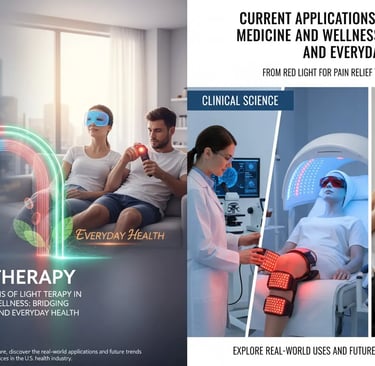Becoming the world's leading health appliance brand, bringing "professional physiotherapy home," and making a healthy life easily accessible.
Current Applications of Light Therapy in Medicine and Wellness: Bridging Clinical Science and Everyday Health
Explore how light therapy (Phototherapy) is transforming modern medicine and wellness. From red light therapy for pain relief to blue light therapy for skincare, discover the real-world applications and future trends of photobiomodulation devices in the U.S. health industry.
PHOTOTHERAPY BASICS > POPULAR SCIENCE EDITION
YEEQO
11/4/20252 min read


1. Medical Origins and Science of Light Therapy
Light Therapy, also known as Photobiomodulation (PBM), utilizes specific wavelengths of light to stimulate cellular activity and accelerate natural healing processes. Since the mid-20th century, scientific research has confirmed that light energy can enhance mitochondrial function, boost ATP production (cellular energy), and promote tissue regeneration.
Early medical applications included:
Dermatology treatments – for conditions like psoriasis, eczema, and vitiligo (using UVB light).
Neonatal jaundice – using specific blue light to break down excess bilirubin in infants.
Seasonal Affective Disorder (SAD) – light exposure regulates serotonin and melatonin, improving mood and sleep.
2. Modern Medical Uses of Light Therapy
Red and Infrared Light Therapy
Red (630–660nm) and Near-Infrared (810–850nm) wavelengths penetrate deep into the skin, muscles, and joints, making them highly effective for anti-inflammatory and repair functions.
Common clinical applications include:
Post-surgery recovery and accelerated wound healing.
Joint and muscle pain relief, including chronic conditions like arthritis.
Anti-aging and cosmetic applications via collagen production.
In the U.S., many physiotherapy and sports medicine centers now routinely use red light therapy devices to support recovery for athletes and chronic pain patients.
Blue Light Therapy
Blue light (405–470nm) is known for its antibacterial effects and is widely used in acne treatment by targeting P. acnes bacteria. Many LED facial devices combine red and blue light for a synergistic effect—cleansing, calming, and regenerating the skin.
Mental Health and Sleep Regulation
High-lux light therapy lamps are increasingly popular among U.S. consumers to combat SAD, improve morning energy levels, and maintain healthy sleep cycles by effectively mimicking natural daylight exposure.
3. Light Therapy Devices in Everyday Wellness
With advances in LED and miniaturization, light therapy has successfully moved from hospitals and clinics into households. These consumer-grade devices prioritize ease of use, safety, and consistency.
Common home-use products include:
Red light therapy panels for full-body and targeted wellness.
LED facial masks for specialized skin rejuvenation.
Infrared wraps for localized relief of neck and shoulder relaxation.
SAD lamps and mood light therapy units for mental balance.
These devices represent the essential shift toward safe, convenient, and smart wellness solutions that empower individuals to manage their health proactively.
4. The Future of Light Therapy: Smart, Targeted, and Personalized
The next generation of light therapy is defined by:
AI-driven light modulation – automatic adjustment of light intensity and wavelength based on real-time user data.
Multi-spectrum treatment – integrating red, blue, and infrared light for layered, comprehensive care.
Wearable phototherapy – flexible, portable devices for anytime, anywhere health management.
Conclusion
Light therapy is no longer confined to hospitals—it’s now a powerful bridge between medicine, wellness, and technology.
From pain relief to skincare, and from mental balance to cellular repair, phototherapy devices are redefining how we approach daily health in a modern, non-invasive way.
YEEQO
© 2025 YEEQO Health Appliances. All rights reserved.
